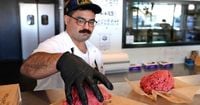President Donald Trump’s latest attempt to rein in record beef prices by importing more meat from Argentina has ignited a firestorm among U.S. ranchers and prompted skepticism among industry experts, raising questions about whether the move will actually benefit American consumers at the checkout line.
On October 21, 2025, Trump announced his plan to increase beef imports from Argentina, aiming to bring down soaring grocery store prices. The move comes as the average price of ground beef in the United States hit an all-time high of $6.32 per pound, according to the latest government report before the recent shutdown. Steak prices have also soared, averaging $12.22 per pound. This price surge is hitting American families hard—after all, who doesn’t love a good burger or a steak dinner? But the president’s proposal has drawn sharp criticism from the very groups that have traditionally formed the backbone of his rural support.
According to the Associated Press, organizations such as the National Cattlemen’s Beef Association and the Ranchers-Cattlemen Action Legal Fund United Stockgrowers of America have spoken out against the plan. These groups, along with other farming organizations, argue that increasing Argentine imports could undercut American ranchers and feedlot operators, who are finally enjoying some rare profitable years after a long stretch of hardship. "I love ‘Make America Great Again’ rhetoric. I love ‘America First’ rhetoric. But to me this feels a lot like the failed policies of the past—the free trade sourcing cheap global goods," South Dakota rancher Brett Kenzy told AP.
Industry experts aren’t convinced the plan will have the intended effect on consumer prices. Argentine beef currently makes up only about 2% of U.S. beef imports, and even doubling that figure would barely move the needle. Kansas State University agricultural economist Glynn Tonsor explained, "Argentina can’t produce enough beef to offset those other losses of imports." Through July 2025, the United States imported 72.5 million pounds of Argentine beef—dwarfed by the more than 15 billion pounds produced domestically. Most of the imported beef consists of lean trimmings used in ground beef production rather than the pricier steaks that dominate American dinner tables. As a result, while hamburger prices might see a slight shift, steak prices are unlikely to budge.
The current price crunch is the result of a perfect storm. The U.S. cattle herd is now at its smallest size since 1961, a consequence of years of drought and low cattle prices. At the same time, beef imports from other major exporters have taken a hit. Imports from Brazil are down due to the 50% tariffs imposed by Trump himself, while shipments from Mexico have been limited as the country battles a flesh-eating pest. The upshot? Supply is tight, and demand remains robust.
For ranchers like Bryant Kagay of Amity, Missouri, the president’s plan feels like a gut punch just as things were starting to look up. "Ranchers are finally getting prices that are going to make up for some really bad years in the past with the drought, low prices and high costs. We finally get some good prices. And we start talking about government policy to bring down prices," said Texas A&M livestock economist David Anderson, as reported by AP. Kagay himself noted that cattle prices for a 1,250-pound animal slipped more than $100 from an average of around $3,000 immediately after Trump floated the idea of boosting imports. Prices have since recovered somewhat, but the uncertainty lingers.
Uncertainty, in fact, is one of the main concerns voiced by the ranching community. As Tonsor put it, "We’re always going to have uncertainty in the world. But the more uncertain something is, the less likely most are to put money on the line." If ranchers fear that government policy could suddenly shift the market, they may be less inclined to invest in expanding their herds—potentially exacerbating the very supply issues Trump’s plan is meant to address.
There’s also a sense among ranchers that the plan contradicts the administration’s previous stance on tariffs and domestic production. Bill Bullard, president of R-CALF, told AP, "It’s a contradiction of what we believed his new course of action was. We thought he was on the right track." Many ranchers had hoped Trump’s tariffs would encourage domestic production and help them compete, not open the door to more foreign beef.
On the other side of the equation, Argentine livestock producers are eager for the opportunity. Augusto Wallace, an Argentine rancher, noted, "Whenever an additional buyer comes, it’s beneficial for everyone, right? For all the producers." But some economists caution that if Argentina exports too much beef, it could drive up prices for their own consumers—a delicate balance for any exporting nation.
Amid the uproar, the Trump administration has sought to reassure both ranchers and consumers. Agriculture Secretary Brooke Rollins appeared on CNBC on October 21, 2025, promising more details soon about the Argentina plan and a broader effort to boost U.S. beef production. According to Rollins, the administration is considering opening more land for grazing, building new processing plants, and securing trade deals to open up new markets for American beef. "The bigger supply—even aligned with a bigger demand—is going to allow those prices to come down, but also to have a vital industry for these ranchers to be able to survive, which is what we’ve got to do," Rollins said.
Senator John Hoeven, a North Dakota Republican, echoed the importance of supporting American cattle ranchers. After discussions with Trump and other administration officials, Hoeven told reporters, "It’s very important that we support our cattle ranchers," and said he expected to learn more about the specifics of the policy soon.
Some ranchers remain hopeful that Trump will reconsider. Kagay, who voted for Trump in the last election, expressed his disappointment: "I continue to see things that I don’t really think are in the best interest of our country and the average citizen. I guess I hope he starts to see that and quits worrying about punishing opponents and winning whatever battle he’s involved in, and then tries to do what’s best for everybody."
Others, like South Dakota rancher Cory Eich, are skeptical that the proposal will have a lasting impact. "Nobody’s happy about it, let’s put it that way. Personal opinion, I thought it was kind of a ruse when he mentioned it. I mean, it’s coming from Trump, so take everything there with a grain of salt," Eich remarked.
As the administration prepares to release more details, the debate over beef imports is far from settled. With American consumers feeling the pinch at the grocery store and ranchers wary of policy shifts, the coming months will reveal whether Trump’s plan can satisfy both sides—or leave everyone chewing over tough choices.






